The Maturing Interdisciplinary Relationship between Human Biometeorological Aspects and Local Adaptation Processes: An Encompassing Overview
Abstract
1. Introduction
2. Review Structure
3. Biometeorological Climate Change Adaptation
3.1. Strengthening Interdisciplinary Know-How
3.2. Balancing Top-Down with Bottom-Up Assessments
3.3. High Frequency Thermal Risk Factors
4. Biometeorological Tools and Thermal Wellbeing
4.1. Thermo–Physiological and Climatic Indices
4.2. Bridging the Qualitative with the Quantitative
4.3. Indoor and Outdoor Cumulative Thermal Stress
5. Biometeorological Urban Design/Planning
5.1. Urban Vegetation
- (i)
- As suggested by the comprehensive review undertaken by Berardi, GhaffarianHoseini and GhaffarianHoseini [160] there is a very tactile opportunity to continue the exploration into the further quantification and assessments of interdisciplinary approaches regarding urban landscaping, plantations, construction and that of mechanical/environmental engineering. Moreover and in addition to stipulating the different classification of green roofs, the authors also cross-examined the typologies against their ability in mitigating UHI/air pollution, improve stormwater management, reduce urban noise and augment urban diversity. From the same year, and focused at the city scale, Santamouris [161] identified four categories to determine the particular efficiency of green roofs, namely through: (i) climatological variables, including radiation fluctuations; (ii) optical variables, including changes in albedo and absorptivity of the roof’s vegetation; (iii) thermal variables, including thermal capacity and heat storage; and lastly, (iv) hydrological variables, including the dynamics of latent heat loss due to evaporation of the water vapour from the vegetative material (or in other words, evapotranspiration). Within the more recent study conducted by Shafique, Kim and Rafiq [162], it was revealed how green roofs can aid simulating urban natural hydrology systems, and also reduce factors such as UHI effects. Still within this recent study, the prominence of further interdisciplinary research was recognised, including in accompanying the demand for such technology through economically sustainable methods.
- (ii)
- With regards to the application of green walls and facades, the review study conducted by Hunter, Williams, Rayner, Aye, Hes and Livesley [163] reported that their efficiency must be based on multiple microclimatic factors, including Grad, Ta and V (both adjacent to the structure, and in-between the gap with the respective wall). In the summary of the study, while the significant potential of green facades were recognised in urban contexts, it was adjacently argued that: (i) they are unlikely mechanisms to modulate internal buildings in all types of construction typologies and climatic contexts; and, (ii) its associated engineering terminology is often too specific to be readily understood across design and planning disciplines. Similarly, and also relating the application of these vegetation structures to different climates, and moreover the influences of different vegetative species, Perez, Coma, Martorell and Cabeza [164] came to similar conclusions. Finally, and within the more recent review study conducted by Medl, Stangl and Florineth [165] (and in addition to the recognised positive attributes mentioned above), the authors argued that there still remains a clear need for further interdisciplinary and standardized measurement approaches to guarantee the better application and erection of effective urban green facades.
- (iii)
- While the aforementioned studies also discussed issues of urban air quality and pollution dispersion through urban vegetation, Gallagher, Baldauf, Fuller, Kumar, Gill and McNabola [166] and Abhijith, Kumar, Gallagher, McNabola, Baldauf, Pilla, Broderick, Sabatino and Pulvirenti [168] took this analysis a step further. More specifically, it was identified that wind-tunnel and modelling results provide adequate evaluations, yet further real-world studies are still required to validate such findings. Similarly, and still in line with the aforementioned perspective of Oke [35], both studies moreover suggest that to develop clear guidelines for urban planners with regards to air quality and pollution dispersal; better interdisciplinary ‘channels’ must be fortified to enable such knowledge to be translated into practical guidelines to ensure their effective urban implementation. Convergent conclusions pertaining to the associated translation into urban planning and design tools/guidelines were also met by Janhall [167].
- (iv)
- Undertaking a more socio-economic approach, the review study launched by Soares, Rego, McPherson, Simpson, Peper and Xiao [169] described the application of the Street Tree Resource Analysis Tool for Urban forest Managers (STRATUM) within Lisbon. The results of the study disclosed a clear quantitative breakdown of economic maintenance/managerial costs of urban vegetation species which was subsequently crossed examined with urban ‘energy savings’, air purification, increased property values, reduced stormwater runoff and CO2 emissions. Still predominantly within the socio-economic spectrum, the later review study undertaken by Mullaney, Lucke and Trueman [170] also provided an investigation into financial aspects of urban vegetation. More specifically, beyond also disclosing environmental and socio-economic benefits, the costs/management of detailed characteristics such as pavement damage from tree roots were also case-studied.
- (v)
- In the last segment, the study conducted by Salmond, Tadaki, Vardoulakis, Arbuthnott, Coutts, Demuzere, Dirks, Heaviside, Lim, Macintyre, Mclnnes, and Wheeler [171] undertook a more encompassing perspective, which suggested that based upon the existing literature, there needs to be a locally based bottom-up decision making process. Such a process was argued to be innately better associated with local community engagement to better determine ‘what matters to them’, and not just constructed upon the technical scientific aspects of ecological interventions. As a result, a matured interdisciplinary relationship between these cultural and scientific approaches was suggested to be essential to further exploit the disclosed societal and wider benefits provided by urban vegetation.
5.2. Shade Canopies
5.3. Urban Surface Materials
5.4. Misting Systems
6. Concluding Remarks
- Methods of approaching climatic data from climatic models and meteorological stations/equipment should not rely solely upon singular climatic variables to obtain wholesome evaluations of existing or future human thermal comfort conditions as a result of climate change.
- The information retrieved from such assessments must, unequivocally, be translatable through easy-to-understand guidance for non-climatic experts, and that of the general public. Such interdisciplinary communication channels shall become moreover significant given the expected increase of extreme heat/cold events within urban contexts. Eventually, the sequential multifaceted process of going from identified risk factors, to establishing better thermal response measures and transposing these into municipal climatic policy and guidelines can be strengthened.
- Due to the inherent nature of thermo–physiological risk factors, undertaken assessments and projections must reach a better equilibrium between ‘huge-impact-but-low-frequency’ with that of ‘high-frequency-yet-continuous’ stimulus within the built environment, particularly during summer/winter periods. In this way, thermal sensitive urban planning and design can better tackle both of these different, yet, decisive facets of urban climatology.
- The remarkable and continual evolution of different thermo–physiological indices (including those arising from energy balance stress models, energy balance stain models, statistical/algebraic models and single-parameter models) with that of psychological factors. As mentioned, as this remains a less explored characteristic, this originates the respective opportunity to decrease ‘qualitative subjectivity’ through further research. Such research outlines can be launched through the association between continued physiological cumulative stimulus, circadian rhythm cycles, and anticipated triggers of human psychological behaviour patterns.
- In association to the previous point, such future lines of research shall also diminish the often over-powering differentiation between evaluation methods between outdoor and indoor environments. Although clear why thermal evaluation methods must be different between these environments, the analytical relationship between the two types of environments must be strengthened. As an example, the effects existing/future extreme heat events shall influence both outdoor and indoor environments; meaning that the daily peripatetic transient relationship between the two environments can be better explored in future thermal comfort research. As result, this shall once again present better means of establishing better thermal response measures, both in indoor and in outdoor contexts.
- While singular-variable evaluations pertaining to the thermal benefits of urban vegetation have been vital for thermal comfort studies (including in both IS and PCI typologies), the exclusion of non-temperature variables limit thermo–physiological interface comprehension with the human biometeorological system.
- Given that the biggest potential of shade canopies is to limit the amount of global radiation projected upon the human body, the very limited amount of existing studies examining this aspect needs to be addressed by future research. Here, material types, structure size and distribution can all serve as analytical variables for addressing thermal comfort in open spaces that are particularly susceptible to high amounts of radiation. Ironically, the scientific community has produced a very strong body of research concerning the relationship amongst different urban morphological compositions and that of solar radiation. As a result, a rich body of research into which types of street configurations and orientations will serve as an excellent platform to guide such future research.
- Due to the predominant use of thermally poor preforming materials, (such as urban concrete and asphalt) within cities, while there has been a considerable amount of research into surface materials, there is the opportunity to further explore the application of thermally efficient pavement materials. While existing studies have made clear strides in examining individual material, aggregate and finishing performances, there needs to be further studies that link such materials with other measure typologies within urban fabrics. As an example, there is the prospect to further examine the affiliation with shading patterns resulting from both tree crowns and shading amenities. Since both of these measures can be utilised to reduce the amount of absorbed solar radiation upon a specific type of investigated pavement, the resulting inferences upon emitted infrared radiation, heat storage and convections can be further explored under specific urban conditions/layouts. Such studies will propagate means to address high surface temperatures and inefficient albedos values in local thermal urban planning/design and decision making.
- As a result of the remaining disparity between engineering and design approaches to misting systems within the urban realm, similar to the case of shade canopies, there needs to be additional studies that consider wholesome projects which consider actual influences upon the human biometeorological system. Although commonly found within cities, there is a large opportunity for future studies to continue to dilute the segregation between engineering and thermal sensitive design approaches, even if based upon simple atmospheric principals to accomplish their full potential in attenuating thermal comfort stress without exacerbating atmospheric moisture content levels.
Author Contributions
Funding
Conflicts of Interest
References
- Matzarakis, A. Chapter 14—Climate change and adaptation at regional and local scale. In Tourism and the Implications of Climate Change: Issues and Actions (Bridging Tourism Theory and Practice); Schott, C., Jafari, J., Cai, L., Eds.; Emerald Group Publishing Limited: Bingley, UK, 2010; Volume 3, pp. 237–259. [Google Scholar]
- Matzarakis, A.; Endler, C. Climate change and thermal bioclimate in cities: Impacts and options for adaptation in Freiburg, Germany. Int. J. Biometeorol. 2010, 54, 479–483. [Google Scholar] [CrossRef]
- Nouri, A.S.; Costa, J.P.; Santamouris, M.; Matzarakis, A. Approaches to outdoor thermal comfort thresholds through public space design: A review. Atmosphere 2018, 9, 108. [Google Scholar] [CrossRef]
- Potchter, O.; Shashua-Bar, L. Urban Greenery as a tool for city cooling: The Israeli experience in a variety of climatic zones. In Proceedings of the PLEA 2017—Design to Thrive, Edinburgh, UK, 3–5 July 2017; pp. 2–9. [Google Scholar]
- Nouri, A.S.; Costa, J.P.; Matzarakis, A. Examining default urban-aspect-ratios and sky-view-factors to identify priorities for thermal-sesnsitive public space design in hot-summer Mediterranean climates: The Lisbon case. Build. Environ. 2017, 126, 442–456. [Google Scholar] [CrossRef]
- Fröhlich, D. Development of a microscale model for the thermal environment in complex areas. In Fakultät für Umwelt und Natürliche Ressourcen; der Albert-Ludwigs-Universität: Freiburg im Breisgau, Germany, 2017. [Google Scholar]
- Chen, Y.-C.; Fröhlich, D.; Matzarakis, A.; Lin, T.-P. Urban Roughness Estimation Based on Digital Building Models for Urban Wind and Thermal Condition Estimation—Application of the SkyHelios Model. Atmosphere 2017, 8, 247. [Google Scholar] [CrossRef]
- Santamouris, M.; Kolokotsa, D. Urban. Climate Mitigation Techniques; Earthscan, Routledge: London, UK, 2016. [Google Scholar]
- Santamouris, M. Cooling the buildings—Past, present and future. Energy Build. 2016, 128, 617–638. [Google Scholar] [CrossRef]
- Matos Silva, M. Public Space Design for Flooding: Facing Challenges Presented by Climate Change Adaptation; Universitat de Barcelona: Barcelona, Spain, 2016. [Google Scholar]
- Charalampopoulos, I.; Tsiros, I.; Chronopoulou-Sereli, A.; Matzarakis, A. A methodology for the evaluation fo the human-biolcimatic performance of open spaces. Theor. Appl. Climatol. 2016, 1–10. [Google Scholar]
- Ketterer, C.; Matzarakis, A. Human-biometeorlogical assessment of heat stress reduction by replanning measures in Stuttgart, Germany. Landsc. Urban Plan. 2014, 122, 78–88. [Google Scholar] [CrossRef]
- Matzarakis, A.; Fröhlich, D.; Ketterer, C.; Martinelli, L. Urban bioclimate and micro climate—How to construct cities in the era of climate change. In Climate Change and Sustainable Heritage; Hofbauer, C., Kandjani, E.M., Meuwissen, J., Eds.; Cambridge Scholars Publishing: Cambridge, UK, 2018; pp. 38–61. [Google Scholar]
- Nouri, A.S. A Framework of Thermal Sensitive Urban Design Benchmarks: Potentiating the Longevity of Auckland’s Public Realm. Buildings 2015, 5, 252–281. [Google Scholar] [CrossRef]
- Alcoforado, M.J.; Matzarakis, A. Planning with urban cilmate in different climatic zones. Geographicalia 2010, 57, 5–39. [Google Scholar]
- Nouri, A.S.; Lopes, A.; Costa, J.P.; Matzarakis, A. Confronting potential future augmentations of the physiologically equivalent temperature through public space design: The case of Rossio, Lisbon. Sustain. Cities Soc. 2018, 37, 7–25. [Google Scholar] [CrossRef]
- Alcoforado, M.-J.; Andrade, H.; Lopes, A.; Vasconcelos, J. Application of climatic guidelines to urban planning—The example of Lisbon (Portugal). Landsc. Urban Plan. 2009, 90, 56–65. [Google Scholar] [CrossRef]
- Lopes, A.; Alves, E.; Alcoforado, M.J.; Machete, R. Lisbon Urban Heat Island Updated: New Highlights about the Relationships between Thermal Patterns and Wind Regimes. J. Adv. Meteorol. 2013, 2013, 1–11. [Google Scholar] [CrossRef]
- Nouri, A.S.; Charalampopoulos, I.; Matzarakis, A. Beyond Singular Climatic Variables—Identifying the Dynamics of Wholesome Thermo-Physiological Factors for Existing/Future Human Thermal Comfort during Hot Dry Mediterranean Summers. Int. J. Environ. Res. Public Health 2018, 15, 2362. [Google Scholar] [CrossRef] [PubMed]
- Santamouris, M.; Ding, L.; Fiorito, F.; Oldfield, P.; Osmond, P.; Paolini, R.; Prasad, D.; Synnefa, A. Passive and active cooling for the built environment—Analysis and assessment of the cooling potential of mitigation technologies using performance data form 220 large scale projects. Sol. Energy 2016, 154, 14–33. [Google Scholar] [CrossRef]
- Alchapar, N.; Pezzuto, C.; Correa, E.; Labaki, L. The impact of different cooling strategies on urban air temperatures: The cases of Campinas, Brazil and Mendoza, Argentina. Theor. Appl. Climatol. 2017, 130, 33. [Google Scholar] [CrossRef]
- Wang, Y.; Berardi, U.; Akbari, H. Comparing the effects of urban heat island mitigation strategies for Toronto, Canada. Energy Build. 2016, 114, 2–19. [Google Scholar] [CrossRef]
- Brown, R. Design with Microclimate—The Secret to Comfortable Outdoor Space; Island Press: Washington, DC, USA, 2010. [Google Scholar]
- Nouri, A.S.; Costa, J.P. Placemaking and climate change adaptation: New qualitative and quantitative considerations for the “Place Diagram”. J. Urban Int. Res. Placemaking Urban Sustain. 2017, 10, 1–27. [Google Scholar] [CrossRef]
- Oke, T. The distinction between canopy and boundary layer urban heat islands. J. Atmos. 1976, 14, 268–277. [Google Scholar] [CrossRef]
- Mayer, H.; Höppe, P. Thermal comfort of man in different urban environments. Theor. Appl. Climatol. 1987, 38, 43–49. [Google Scholar] [CrossRef]
- Brown, R.; Gillespie, T. Microclimatic Landscape Design: Creating Thermal Comfort and Energy Efficiency; John Wiley and Sons: Hoboken, NJ, USA, 1995. [Google Scholar]
- Fanger, P. Thermal Comfort: Analysis and Applications in Environmental Engineering; McGraw-Hill Book Company: New York, NY, USA, 1972; p. 244. [Google Scholar]
- Whyte, W.H. The Social Life of Small Urban. Spaces; Project for Public Spaces Inc.: New York, NY, USA, 1980. [Google Scholar]
- Olgyay, V. Design with Climate, Bioclimatic Approach to Architectural Regionalism; Princeton University Press: Princeton, NJ, USA, 1963. [Google Scholar]
- Givoni, B. Man, Climate and Architecture; Applied Science Publishers: London, UK, 1976. [Google Scholar]
- Nikolopoulou, M.; Steemers, K. Thermal comfort and psychological adaptation as a guide for designing urban spaces. Energy Build. 2003, 35, 95–101. [Google Scholar] [CrossRef]
- Shashua-Bar, L.; Tsiros, I.X.; Hoffman, M. Passive cooling design options to ameliorate thermal comfort in urban streets of a Mediterranean climate (Athens) under hot summer conditions. Build. Environ. 2012, 57, 110–119. [Google Scholar] [CrossRef]
- Wilbanks, T.J.; Kates, R.W. Global Change in Local Places: How Scale Matters; Kluwer Academic Publishers: Dordrecht, The Netherlands, 1999; pp. 601–628. [Google Scholar]
- Oke, T. Towards a prescription for the greater use of climatic principles in settlement planning. Energy Build. 1984, 7, 1–10. [Google Scholar] [CrossRef]
- Alcoforado, M.J.; Vieira, H. Urban climate in Portuguese management plans (in Portuguese with abstract in English). Soc. E Territ. 2004, 37, 101–116. [Google Scholar]
- Alcoforado, M.J.; Lopes, A.; Andrade, H. Urban climatic map studies in Portugal. In The Urban Climatic Map: A Methodology for Sustainable Urban Planning; Ng, E., Ren, C., Eds.; Routledge: Abingdon, UK, 2015. [Google Scholar]
- Andrade, H. Bioclima Humano E Temperatura Do Ar Em Lisboa; Universidade de Lisboa: Lisbon, Portugal, 2003. [Google Scholar]
- Oliveira, S.; Andrade, H. An initial assessment of the bioclimatic comfort in an outdoor public space in Lisbon. Int. J. Biometeorol. 2007, 69–84. [Google Scholar] [CrossRef]
- Alcoforado, M.J.; Andrade, H. Nocturnal urban heat island in Lisbon (Portugal): Main features and modelling attempts. Theor. Appl. Climatol. 2006, 84, 151–159. [Google Scholar] [CrossRef]
- Alcoforado, M.J.; Lopes, A.; Alves, E.; Canário, P. Lisbon Heat Island; Statistical Study. Finisterra 2014, 98, 61–80. [Google Scholar]
- Lopes, A. Modificações No Clima Da Lisboa Como Consequência Do Crescimento Urbano; University of Lisbon: Lisbon, Portugal, 2003. [Google Scholar]
- Alcoforado, M.J.; Lopes, A.; Andrade, H.; Vasconcelos, J.; Vieira, R. Observational Studies on Summer Winds in Lisbon (Portugal) and Their Influence on Daytime Regional and Urban Thermal Patterns; Tel Aviv University Tel Aviv: Merhavim, Israel, 2006; pp. 88–112. [Google Scholar]
- Alcoforado, M.J.; Lopes, A.; Andrade, H.; Vasconcelos, J. Orientações Climáticas Para O Ordenamento Em Lisboa (Relatório 4); Centro de Estudos Geográficos da Universidade de Lisboa: Lisboa, Portugal, 2005; p. 83. ISBN 978-972-636-165-7. [Google Scholar]
- Matzarakis, A.; Endler, C. Climate change and urban bioclimate: Adaptation possibilities. In Proceedings of the Seventh International Conference on Urban Climate, Yokohama, Japan, 29 June–3 July 2009. [Google Scholar]
- Algeciras, J.A.R.; Matzarakis, A. Quantification of thermal bioclimate for the management of urban design in Mediterranean climate of Barcelona, Spain. Int. J. Biometeorol. 2015, 8, 1261–1270. [Google Scholar]
- Potchter, O.; Cohen, P.; Lin, T.; Matzarakis, A. Outdoor human thermal perception in various climates: A comprehensive review of approaches, methods and quantification. Sci. Total Environ. 2018, 631–632, 390–406. [Google Scholar] [CrossRef]
- Lin, T.-P. Thermal perception, adaptation and attendance in a public square in hot and humid regions. Build. Environ. 2009, 44, 2017–2026. [Google Scholar] [CrossRef]
- Andreou, E. Thermal comfort in outdoor spaces and urban canyon microclimate. Renew. Energy 2013, 55, 182–188. [Google Scholar] [CrossRef]
- Santamouris, M.; Xirafi, F.; Gaitani, N.; Saliari, M.; Vassilakopoulou, K. Improving the microclimate in a dense urban area using experimental and theoretical techniques—The case of Marousi, Athens. Int. J. Vent. 2012, 11, 1–16. [Google Scholar] [CrossRef]
- Labaki, L.C.; Fontes, M.S.G.d.C.; Bueno-Bartholomei, C.L.; Dacanal, C. Thermal comfort in public open spaces: Studies in pedestrian streets in São Paulo state, Brazil. Ambiente Construído 2012, 12, 167–183. [Google Scholar] [CrossRef]
- Fröhlich, D.; Gangwisch, M.; Matzarakis, A. Effect of radiation and wind on thermal comfort in urban environments—Applications of the RayMan and SkyHelios Model. Urban Clim. 2019, 27, 1–7. [Google Scholar] [CrossRef]
- Katzschner, L. Microclimatic Thermal Comfort Analysis in Cities for Urban Planning and Open Space Design Network for Comfort and Energy Use in Buildings; NCUB: London, UK, 2006. [Google Scholar]
- Matzarakis, A.; Amelung, B. Physiological Equivalent Temperature as Indicator for Impacts of Climate Change on Thermal Comfort of Humans. In Seasonal Forecasts, Climatic Change and Human Health. Advances in Global Research 30; Thomson, M.C., Garcia-Herrera, R., Beniston, M., Eds.; Springer: Berlin, Germany, 2008; pp. 161–172. [Google Scholar]
- Matzarakis, A.; Georiadis, T.; Rossi, F. Thermal bioclimate analysis for Europe and Italy. IL Nuovo Cim. 2007, 30, 623–631. [Google Scholar]
- IPCC. Climate Change 2014: Synthesis Report. Contribution of Working Groups I, II and III to the Fifth Assessment Report of the Intergovernmental Panel on Climate Change; IPCC: Geneva, Switzerland, 2014; p. 151. [Google Scholar]
- IPCC. IPCC Special Report Emission Scenarios, A Special Report of Working Group III of the Intergovernmental Panel on Climate Change; IPCC: Cambridge, UK, 2000; p. 27. [Google Scholar]
- Giannaros, T.; Lagouvardos, K.; Kotroni, V.; Matzarakis, A. Operational forecasting of human-biometeorological conditions. Int. J. Biometeorol. 2018, 1–5. [Google Scholar] [CrossRef]
- Hebbert, M.; Webb, B. Towards a Liveable Urban Climate: Lessons from Stuttgart. In Liveable Cities: Urbanising World: Isocarp 07; Routledge: Manchester, UK, 2007. [Google Scholar]
- Kántor, N.; Chen, L.; Gal, C.V. Human-biometeorological significance of shading in urban public spaces—Summertime measurements in Pécs, Hungary. Landsc. Urban Plan. 2018, 170, 241–255. [Google Scholar] [CrossRef]
- Nouri, A.S. Addressing Urban Outdoor Thermal Comfort Thresholds through Public Space Design—A Bottom-Up Interdisciplinary Research Approach for Thermal Sensitive Urban Design in An Era of Climate Change: The Lisbon Case; University of Lisbon: Lisbon, Portugal, 2018. [Google Scholar]
- Nouri, A.S. A bottom-up perspective upon climate change—Approaches towards the local scale and microclimatic assessment. In Green Design, Materials and Manufacturing Processes; Bártolo, H., Ed.; Taylor & Francis: Lisbon, Portugal, 2013; pp. 119–124. [Google Scholar]
- Spagnolo, J.; de-Dear, R. A field study of thermal comfort in outdoor and semi-outdoor environments in subtropical Sydney, Australia. Build. Environ. 2003, 38, 721–738. [Google Scholar] [CrossRef]
- VDI. Part I: Environmental meteorology, methods for the human-biometeorological evaluation of climate and air quality for the urban and regional planning at regional level. Part I: Climate. In VDI/DIN-Handbuch Reinhaltung der Luft; Verein Deutscher Ingenieure: Düsseldorf, Germany, 1998; p. 29. [Google Scholar]
- Beshir, M.; Ramsey, J. Heat Stress Indicies: A Review Paper. Int. J. Ind. Ergon. 1988, 3, 89–102. [Google Scholar] [CrossRef]
- Lin, T.-P.; Tsai, K.-T.; Hwang, R.-L.; Matzarakis, A. Quantification of the effect of thermal indices and sky view factor on park attendance. Landsc. Urban Plan. 2012, 107, 137–146. [Google Scholar] [CrossRef]
- Pantavou, K.; Santamouris, M.; Asimakopoulos, D.; Theoharatos, G. Empirical calibtation of thermal indices in an urban outdoor Mediterranean environment. Build. Environ. 2014, 80, 283–292. [Google Scholar] [CrossRef]
- Freitas, C.; Grigorieva, E. A comprehensive catalogue and classification of human thermal climate indices. Int. J. Biometeorol. 2015, 59, 1–12. [Google Scholar] [CrossRef] [PubMed]
- Fröhlich, D.; Matzarakis, A. A quantitative sensitivity analysis on the behaviour of common thermal indices under hot and windy conditions in Doha, Qatar. Theor. Appl. Climatol. 2015, 124, 179–187. [Google Scholar] [CrossRef]
- Coccolo, S.; Kämpf, J.; Scartezzini, J.; Pearlmutter, D. Outdoor thermal comfort and thermal stress: A comprehensive review on models and standards. Urban Clim. 2016, 18, 33–57. [Google Scholar] [CrossRef]
- Freitas, C.; Grigorieva, E. A comparison and appraisal of a comprehensive range of human thermal climate indices. Int. J. Biometeorol. 2016, 61, 1–26. [Google Scholar] [CrossRef] [PubMed]
- Golasi, I.; Salata, F.; Vollaro, E.; Coppi, M. Complying with the demand of standarization in outdoor thermal comfort: A first approach to the Global Outdoor Comfort Index (GOCI). Build. Environ. 2018, 130, 104–119. [Google Scholar] [CrossRef]
- Charalampopoulos, I. A comparative sensitivity analysis of human thermal comfort indices with generalized additive models. Theor. Appl. Climatol. 2019, 1–18. [Google Scholar] [CrossRef]
- Charalampopoulos, I.; Nouri, A.S. Investigating the behaviour of human thermal indices under divergent atmospheric conditions: A sensitivity analysis approach. Atmosphere 2019, 10, 580. [Google Scholar] [CrossRef]
- Staiger, H.; Laschewski, G.; Matzarakis, A. Selection of appropriate thermal indices for applications in human biometeorological studies. Atmosphere 2019, 10, 18. [Google Scholar] [CrossRef]
- Guo, H.; Aviv, D.; Loyola, M.; Teitelbaum, E.; Houchois, N.; Meggers, F. On the understanding of the mean radiant temperature within both the indoor and outdoor environment, a critical review. Renew. Sustain. Energy Rev. 2019, in press. [Google Scholar] [CrossRef]
- Miao, C.; Yu, S.; Hu, Y.; Zhang, H.; He, X.; Chen, W. Review of methods used to estimate the sky view factor in urban street canyons. Build. Environ. 2019, 168, 6497. [Google Scholar] [CrossRef]
- Tinz, B.; Jendrizky, G. Europa- und Weltkarten der gefühlten Temperatur. In Beiträge zur Klima- und Meeresforschung; Chmielewski, F., Foken, T., Eds.; Deutschland: Berlin/Bayreuth, Germany, 2003; pp. 111–123. [Google Scholar]
- Gagge, A.; Fobelets, P.; Bergland, L. A standard predictive index of human responce to thermal environment. Ashrae Trans. 1986, 92, 709–731. [Google Scholar]
- Gonzalez, R.; Nishi, Y.; Gagge, A. Experimental evaluation of standard effective temperature: A new biometeorological index of man’s thermal discomfort. Int. J. Biometeorol. 1974, 18, 1–15. [Google Scholar] [CrossRef] [PubMed]
- de-Dear, R.; Pickup, R. An outdoor thermal comfort index (OUT_SET*)—Part I—The model and its assumptions. In Proceedings of the International Conference on Urban Climatology Macquarie University, Sydney, Australia, 8–12 November 1999. [Google Scholar]
- Unger, J. Comparisons of urban and rural bioclimatological conditions in the case of a Central-European city. Int. J. Biometeorol. 1999, 43, 139–144. [Google Scholar] [CrossRef]
- Alfano, D.A.; Olesen, B.; Palella, B. Polv Ole Fanger’s impact ten years later. Energy Build. 2017, 152, 243–249. [Google Scholar] [CrossRef]
- Masterton, J.; Richardson, F. Humidex: A Method of Quantifying Human Discomfort Due to Excessive Heat and humidty; Environment Canada: Downsview, ON, Canada, 1979. [Google Scholar]
- Kenny, A.; Warland, S.; Brown, R. Part A: Assessing the performance of the COMFA outdoor thermal comfort model on subjects performing physical activity. Int. J. Biometeorol. 2009, 53, 415–428. [Google Scholar] [CrossRef] [PubMed]
- Brown, R.; Gillespie, T. Estimating outdoor thermal comfort using a cylindrical radiation thermometer and an energy budget model. Int. J. Biometeorol. 1986, 30, 43–52. [Google Scholar] [CrossRef]
- Jendritzky, G.; Maarouf, A.; Fiala, D.; Staiger, H. An update on the development of a Universal Thermal Climate Index. In Proceedings of the 15th Conference Biometeorology/Aerobiology and 16th International Congress of Biometeorology, Kansas City, KS, USA, 27 October 2002; pp. 129–133. [Google Scholar]
- Jendritzky, G.; de-Dear, R.; Havenith, G. UTCI—Why another thermal index? Int. J. Biometeorol. 2012, 56, 421–428. [Google Scholar] [CrossRef]
- Havenith, G.; Fiala, D.; Błazejczyk, K.; Richards, M.; Bröde, P.; Holmér, I.; Rintamaki, H.; Benshabat, Y.; Jendritzky, G. The UTCI clothing model. Int. J. Biometeorol. 2012, 56, 461–470. [Google Scholar] [CrossRef]
- Yaglou, C.; Minard, D. Control of heat casualties at military training centers. AMA Arch. Ind. Health 1957, 16, 302–316. [Google Scholar]
- Alfano, F.; Malchaire, J.; Palella, B.; Riccio, G. WBGT index revisited after 60 years of use. Ann. Occup. Hyg. 2014, 58, 955–970. [Google Scholar]
- Malchaire, J.; Piette, A.; Kampmann, B.; Mehnerts, P.; Gebhardt, H.; Havenith, G.; Hartog, E.; Holmer, I.; Parsons, K.; Alfanoss, G.; et al. Development and Validation of the Predicted Heat Strain Model. Ann. Occup. Hyg. 2001, 45, 123–135. [Google Scholar] [CrossRef]
- Höppe, P. The physiological equivalent temperature—A universal index for the biometeorological assessment of the thermal environment. Int. J. Biometeorol. 1999, 43, 71–75. [Google Scholar] [CrossRef] [PubMed]
- Matzarakis, A.; Mayer, H.; Iziomon, G.M. Applications of a universal thermal index: Physiological equivalent temperature. Int. J. Biometeorol. 1999, 42, 76–84. [Google Scholar] [CrossRef] [PubMed]
- Chen, Y.-C.; Matzarakis, A. Modified physiologically equivalent temperature—Basics and applications for western European climate. Theor. Appl. Climatol. 2017, 132, 1–15. [Google Scholar] [CrossRef]
- Binarti, F.; Koerniawan, M.; Triyadi, S.; Utami, S.; Matzarakis, A. A review of outdoor thermal comfort indices and neutral ranges for hot-humid regions. Urban Clim. 2020, 31, 100531. [Google Scholar] [CrossRef]
- Höppe, P. The Energy Balance in Humans (Original Title—Die Energiebilanz des Menschen); Universitat Munchen, Meteorologisches Institut: Munich, Germany, 1984. [Google Scholar]
- Lin, T.-P.; Yang, S.-R.; Chen, Y.-C.; Matzarakis, A. The potential of a modified physiologically equivalent temperature (mPET) based on local thermal comfort perception in hot and humid regions. Theor. Appl. Climatol. 2018, 135, 873–876. [Google Scholar] [CrossRef]
- Nouri, A.S.; Fröhlich, D.; Silva, M.M.; Matzarakis, A. The Impact of Tipuana tipu Species on Local Human Thermal Comfort Thresholds in Different Urban Canyon Cases in Mediterranean Climates: Lisbon, Portugal. Atmosphere 2018, 9, 2–28. [Google Scholar]
- de-Dear, R.; Foldvary, V.; Zhang, H.; Arens, E.; Luo, M.; Parkison, T.; Du, X.; Zhang, W.; Chun, C.; Liu, S. Comfort is in the mind of the beholder: A review of progress in adaptative thermal comfort research over the past two decades. In Proceedings of the 5th International Conference on Human-Environmental System, Nagoya, Japan, 29 October–2 November 2016. [Google Scholar]
- Kim, J.; de-Dear, R. Thermal comfort expectations and adaptative behavioural characteristics of primary and secondary school students. Build. Environ. 2017, 127, 13–22. [Google Scholar] [CrossRef]
- de-Dear, R.; Kim, J.; Candido, C.; Deuble, M. Adaptive thermal comfort in Australian school classrooms. Build. Res. Inf. 2015, 43, 383–398. [Google Scholar] [CrossRef]
- Humphreys, M.; Nicol, F.; Raja, I. Field studies of indoor thermal comfort and the progress of the adaptive approach. J. Adv. Build. Energy Res. 2007, 1, 55–88. [Google Scholar] [CrossRef]
- de-Dear, R. Thermal comfort in air-conditioned office buildings in the tropics. In Standards for Thermal Comfort: Indoor Air Temperature Standards for the 21st Century; Nicol, F., Humphreys, M., Sykes, O., Roaf, S., Eds.; Chapman and Hall: London, UK, 1995. [Google Scholar]
- Heijs, W.; Stringer, P. Research on residential thermal comfort: Some contributions from environmental psychology. J. Environ. Psychol. 1988, 8, 235–247. [Google Scholar] [CrossRef]
- Song, X.; Yang, L.; Zheng, W.; Ren, Y.; Lin, Y. Analysis on human adaptative levels in different kinds of indoor thermal environment. Procedia Eng. 2015, 121, 151–157. [Google Scholar] [CrossRef]
- Chen, L.; Ng, E. Outdoor thermal comfort and outdoor activities: A Review of research in the past decade. Cities 2012, 118–125. [Google Scholar] [CrossRef]
- Nouri, A.S.; Costa, J.P. Addressing thermophysiological thresholds and psychological aspects during hot and dry mediterranean summers through public space design: The case of Rossio. Build. Environ. 2017, 118, 67–90. [Google Scholar] [CrossRef]
- Nikolopoulou, M.; Baker, N.; Steemers, K. Thermal Comfort in Outdoor Urban Spaces: Understanding the Human Parameter. Sol. Energy 2001, 70, 227–235. [Google Scholar] [CrossRef]
- Thorsson, S.; Lindqvist, M.; Lindqvist, S. Thermal bioclimatic conditions and patterns of behaviour in an urbn park in Göteborg, Sweden. Int. J. Biometeorol. 2004, 48, 149–156. [Google Scholar] [CrossRef]
- Katzschner, L. Behaviour of people in open spaces in dependence of thermal comfort conditions. In Proceedings of the 23rd Conference on Passive and Low Energy Architecture, Geneva, Switzerland, 6–8 September 2006. [Google Scholar]
- Nikolopoulou, M.; Steemers, K. Thermal comfort and psychological adaptation as a guide for designing urban spaces. Energy Build. 2003, 35, 95–101. [Google Scholar] [CrossRef]
- Thorsson, S.; Honjo, T.; Lindberg, F.; Eliasson, I.; Lim, E.-M. Thermal comfort and outdoor activity in Japanese urban public places. Environ. Behav. 2007, 39, 661–684. [Google Scholar] [CrossRef]
- Zacharias, J.; Stathopoulos, T.; Wu, H. Spatial behavior in San Francisco’s plazas: The effects of microclimate, other people, and environmental design. Environ. Behav. 2004, 36, 639–658. [Google Scholar] [CrossRef]
- Velazquez, R.; Alvarez, S.; Guerra, J. Climatic Control. of the Open Spaces in Expo. 1992; College of Industrial Engineering of Seville: Seville, Spain, 1992. [Google Scholar]
- Hirashima, S.; Assis, E.; Nikolopoulou, M. Daytime thermal comfort in urban spaces: A field study in Brazil. Build. Environ. 2016, 107, 243–253. [Google Scholar] [CrossRef]
- Brager, G.; de-Dear, R. Thermal adaptation in the built environment; A literature review. Energy Build. 1998, 27, 83–96. [Google Scholar] [CrossRef]
- National Benefits Assessment. Energy Build. 1992, 18, 171–291.
- Matzarakis, A.; Mayer, H. Heat Stress in Greece. Int. J. Biometeorol. 1997, 41, 34–39. [Google Scholar] [CrossRef] [PubMed]
- Matzarakis, A.; Mayer, H. Another Kind of Environmental Stress: Thermal Stress. WHO Colloborating Centre for Air Quality Management and Air Pollution Control. News Lett. 1996, 18, 7–10. [Google Scholar]
- IPCC. Synthesis Report—An Assessment of the Intergovermental Panel on Climate Change—Adopted Section by Section at IPCC Plenary XXVII (Valencia, Spain, 12–17 November 2007); IPCC: Geneva, Switzerland, 2007; p. 104. [Google Scholar]
- IPCC. Climate Change 2013: The Physical Science Basis. Working Group Contribution to the IPCC 5th Assessment Report; IPCC: Cambridge, UK, 2013. [Google Scholar]
- Kovats, R.; Ebi, K. Heatwaves and public health in Europe. J. Public Health 2006, 16, 592–599. [Google Scholar] [CrossRef] [PubMed]
- Matzarakis, A. The Heat Health Warning System of DWD—Concept and Lessons Learned. In Perspectives on Atmospheroc Sciences; Karacostas, T., Bais, A., Nastos, P., Eds.; Springer Atmospheric Sciences: Cham, Switzerland, 2016. [Google Scholar]
- Nogueira, P.; Falcão, J.; Contreiras, M.; Paixão, E.; Brandão, J.; Batista, I. Mortality in Portugal associated with the heat wave of August 2003: Early estimation of effect, using a rapid method. Eurosurveillance 2005, 10, 5–6. [Google Scholar] [CrossRef]
- Oke, T. The urban energy balance. J. Prog. Phys. Geogr. 1988, 12, 38. [Google Scholar] [CrossRef]
- Stathopoulou, M.; Synnefa, A.; Cartalis, C.; Santamouris, M.; Karlessi, T.; Akbari, H. A surface heat island study of Athens using high-resolution satellite imagery and measurements of the optical and thermal properties of commonly used building and paving materials. J. Sustain. Energy 2009, 28, 59–76. [Google Scholar] [CrossRef]
- Akbari, H.; Cartalis, C.; Kolokotsa, D.; Muscio, A.; Pisello, A.L.; Rossi, F.; Santamouris, M.; Synnefa, A.; Wong, N.H.; Zinzi, M. Local climate change and urban heat island mitigation techniques—The state of the art. J. Civ. Eng. Manag. 2016, 22, 1–16. [Google Scholar] [CrossRef]
- Yang, J.; Wang, Z.; Kaloush, K. Unintended Consequences—A Research Synthesis Examining the Use of Reflective Pavements to Mitigate the Urban Heat Island Effect (Revised April 2014); Arizona State University National Center for Excellence for SMART Innovations: Phoenix, Arizona, 2013. [Google Scholar]
- Santamouris, M. Using cool pavements as a mitigation strategy to fight urban heat islands—A review of the actual developments. J. Renew. Sustain. Energy Rev. 2013, 26, 224–240. [Google Scholar] [CrossRef]
- Dimoudi, A.; Zoras, S.; Kantzioura, A.; Stogiannou, X.; Kosmopoulos, P.; Pallas, C. Use of cool materials and other bioclimatic interventions in outdoor places in order to mitigate the urban heat island in a medium size city in Greece. Sustain. Cities Soc. 2014, 13, 89–96. [Google Scholar] [CrossRef]
- Ca, T.; Asaeda, T.; Abu, M. Reductions in air conditioning energy caused by a nearby park. Energy Build. 1998, 29, 83–92. [Google Scholar] [CrossRef]
- Elhelw, M. Analysis of energy management for heating, ventilating and air-conditioning systems. Alex. Eng. J. 2016, 55, 811–818. [Google Scholar] [CrossRef][Green Version]
- Song, L.; Zhou, X.; Zhang, J.; Zheng, S.; Yan, S. Air-conditioning usage pattern and energy consumption for residential space heating in Shanghai China. Procedia Eng. 2017, 205, 3138–3145. [Google Scholar] [CrossRef]
- Lundgren-Kownacki, K.; Hornyanszky, E.; Chu, T.; Olsson, J.; Becker, P. Challenges of using air conditioning in an increasingly hot climate. Int. J. Biometeorol. 2017, 62, 401–412. [Google Scholar] [CrossRef]
- Isaac, M.; Vuuren, D.P.V. Modeling global residential sector energy demand for heating and air conditioning in the contect of climate change. Energy Policy 2009, 37, 507–521. [Google Scholar] [CrossRef]
- Givoni, B. Comfort, climate analysis and building design guidelines. Energy Build. 1991, 18, 11–23. [Google Scholar] [CrossRef]
- Muzet, A.; Libert, J.; Candas, V. Ambient temperature and human sleep. Experientia 1984, 40, 425–429. [Google Scholar] [CrossRef]
- Glotzbach, S.; Heller, H. Temperature regulation. In Principles and Practice of Sleep Medicine; Kryger, M., Roth, T., Dement, W., Eds.; Saunders: New York, NY, USA, 1999; pp. 289–304. [Google Scholar]
- Lan, L.; Tsuzuki, K.; Liu, Y.; Lian, Z. Thermal environment and sleep quality: A review. Energy Build. 2017, 149, 101–113. [Google Scholar] [CrossRef]
- Haskell, E.; Palca, J.; Walker, J.; Berger, R.; Heller, H. The effects of high and low ambient temperatures on human sleep stages. Electro-Clin. Neurophysiol. 1981, 51, 494–501. [Google Scholar] [CrossRef]
- Sapolsky, R. Why Zebras Don’t Get Ulcers, 3rd ed.; Holt Paperbacks: New York, NY, USA, 2004. [Google Scholar]
- Law, T. The Future of Thermal Comfort in An Energy-Contrained World; University of Tasmania Australia: Hobart, Australia, 2013. [Google Scholar]
- Gisolfi, C.; Mora, M. The Hot Brain: Survival, Temperature, and the Human Body; MIT Press: Cambridge, MA, USA, 2000. [Google Scholar]
- Parmeggiani, P. Thermoregulation and sleep. Front. Biosci. 2003, 8, 557–567. [Google Scholar] [CrossRef] [PubMed]
- Parmeggiani, P. Interaction between sleep and thermoregulation: An aspect of the control of behavioural states. Sleep 1987, 10, 426–435. [Google Scholar] [CrossRef] [PubMed]
- Okamoto-Mizuno, K.; Mizuno, K. Effects of thermal environment on sleep and circadian rhythm. J. Physiol. Anthropol. 2012, 31, 1–9. [Google Scholar] [CrossRef] [PubMed]
- Tsuzuki, K.; Okamoto-Mizuno, K.; Mizuno, K. Effects of humid heat exposure on sleep, thermoregulation, melatonin, and microclimate. J. Therm. Biol. 2004, 29, 31–36. [Google Scholar] [CrossRef]
- Okamoto-Mizuno, K.; Mizuno, K.; Michie, S.; Maeda, A.; Lizuka, S. Effects of humid heat exposure on human sleep stages and body temperature. Sleep 1999, 22, 767–773. [Google Scholar]
- Libert, J.; Di, J.; Fukuda, H.; Muzet, A.; Ehrhart, J.; Amoros, C. Effect of continuous heat exposure on sleep stages in humans. Sleep 1988, 11, 195–209. [Google Scholar] [CrossRef]
- Bach, V.; Maingourd, Y.; Libert, J.; Oudart, H.; Muzet, A.; Lenzi, P.; Johnson, L. Effect of continuous heat exposure on sleep during partial sleep deprivation. Sleep 1994, 17, 1–10. [Google Scholar] [CrossRef]
- Nastos, P.; Matzarakis, A. Human-biometeorological effects on sleep in Athens, Greece: A Preliminary Evaluation. Indoor Built Environ. 2008, 17, 535–542. [Google Scholar] [CrossRef]
- Douglas, J.; Krieger, J.; Peter, J.; Rauscher, H.; Stradling, J. Sleep Related Breathing Disorders; Springer-Verlag Wien: New York, NY, USA, 1992. [Google Scholar]
- Roscoe, J.; Kaufman, M.; Matteson-Rusby, S.; Palesh, O.; Ryan, J.; Kohli, S.; Perlis, M.; Morrow, G. Cancer-Related Fatigue and Sleep Disorders. Oncologist 2007, 12, 35–42. [Google Scholar] [CrossRef]
- Givoni, B. Impact of planted areas on urban environmental quality: A review. J. Atmos. Environ. 1991, 25B, 289–299. [Google Scholar] [CrossRef]
- Santamouris, M. Heat Island Research in Europe: The State of the Art. Adv. Build. Energy Res. 2007, 1, 123–150. [Google Scholar] [CrossRef]
- Bowler, D.E.; Buyung-Ali, L.; Knight, T.M.; Pullin, A.S. Urban greening to cool towns and cities: A systematic review of the empirical evidence. Landsc. Urban Plan. 2010, 97, 147–155. [Google Scholar] [CrossRef]
- Gago, E.; Roldan, J.; Pacheco-Torres, R.; Ordonez, J. The city and urban heat islands: A review of strategies to mitigate adverse effects. Renew. Sustain. Energy Rev. 2013, 25, 749–758. [Google Scholar] [CrossRef]
- Qiu, G.-Y.; Li, H.-Y.; Zhang, Q.-T.; Chen, W.; Liang, X.-J.; Li, X.-Z. Effects of Evapotranspiration on Mitigation of Urban Temperature by Vegetation and Urban Agriculture. J. Integr. Agric. 2013, 12, 1307–1315. [Google Scholar] [CrossRef]
- Berardi, U.; GhaffarianHoseini, A.; GhaffarianHoseini, A. State-of-the-art analysis of the environmental benefits of green roofs. Appl. Energy 2014, 115, 411–428. [Google Scholar] [CrossRef]
- Santamouris, M. Cooling the cities—A review of reflective and green roof mitigation technologies to fight heat island and improve comfort in urban environments. Sol. Energy 2014, 103, 682–703. [Google Scholar] [CrossRef]
- Shafique, M.; Kim, R.; Rafiq, M. Green roof benefits, opportunities and challenges—A review. Renew. Sustain. Energy Rev. 2018, 90, 757–773. [Google Scholar] [CrossRef]
- Hunter, A.; Williams, N.; Rayner, J.; Aye, L.; Hes, D.; Livesley, S. Quantifying the thermal performance of green facades: A critical review. Ecol. Eng. 2014, 63, 102–113. [Google Scholar] [CrossRef]
- Perez, G.; Coma, J.; Martorell, I.; Cabeza, L. Vertical Greenery Systems (VGS) for energy saving in buildings: A review. Renew. Sustain. Energy Rev. 2014, 39, 139–165. [Google Scholar] [CrossRef]
- Medl, A.; Stangl, R.; Florineth, F. Vertical greening systems—A review on recent technologies and research advancement. Build. Environ. 2017, 125, 227–239. [Google Scholar] [CrossRef]
- Gallagher, J.; Baldauf, R.; Fuller, C.; Kumar, P.; Gill, L.; McNabola, A. Passive methods for improving air quality in the built environment; A review of porous and solid barriers. Atmos. Environ. 2015, 120, 61–70. [Google Scholar] [CrossRef]
- Janhall, S. Review on urban vegetation and particle air pollution—Deposition and dispersion. J. Atmos. Environ. 2005, 105, 130–137. [Google Scholar] [CrossRef]
- Abhijith, K.; Kumar, P.; Gallagher, J.; McNabola, A.; Baldauf, R.; Pilla, F.; Broderick, B.; Sabatino, S.; Pulvirenti, B. Air pollution abatement performances of green infrastructure in open road and built-up street canyon environments—A review. Atmos. Environ. 2017, 162, 71–86. [Google Scholar] [CrossRef]
- Soares, A.; Rego, F.; McPherson, E.; Simpson, J.; Peper, P.; Xiao, Q. Benefits and costs of street tree in Lisbon, Portugal. Urban. For. Urban Green. 2011, 10, 69–78. [Google Scholar] [CrossRef]
- Mullaney, J.; Lucke, T.; Trueman, S. A review of benefits and challenges in growing street trees in paved urban environments. Landsc. Urban Plan. 2015, 134, 157–166. [Google Scholar] [CrossRef]
- Salmond, J.; Tadaki, M.; Vardoulakis, S.; Arbuthnott, K.; Coutts, A.; Demuzere, M.; Dirks, K.; Heaviside, C.; Lim, S.; Macintyre, H.; et al. Health and climate related ecosystem services provided by street trees in the urban environment. Environ. Health 2016, 15, 96–171. [Google Scholar] [CrossRef]
- Peel, M.; Finlayson, B.; McMahon, T. Updated world map of the Koppen-Geiger climate classification. J. Hydrol. Earth Syst. Sci. 2007, 11, 1633–1644. [Google Scholar] [CrossRef]
- Taha, H.; Akbari, H.; Rosenfeld, A. Vegetation Canopy Micro-Climate: A Field Project in Davis, California; Lawrence Berkeley Laboratory, University of California: Berkley, CA, USA, 1988. [Google Scholar]
- Narita, K.; Sugawara, H.; Honjo, T. Effects of roadside trees on the thermal environment within a street canyon. Geogr. Rep. Tokyo Metrop. Univ. 2008, 43, 41–48. [Google Scholar]
- Tsiros, I. Assessment and energy implications of street air temperature cooling by shade trees in Athens (Greece) under extremely hot weather conditions. J. Renew. Energy 2010, 35, 1866–1869. [Google Scholar] [CrossRef]
- Wong, N.; Jusuf, S. Study on the microclimatic condition along a green pedestrian canyon in Singapore. Archit. Sci. Rev. 2010, 53, 196–212. [Google Scholar] [CrossRef]
- Berry, R.; Livesley, S.; Aye, L. Tree canopy shade impacts on solar irradiance received by building walls and their surface temperature. Build. Environ. 2013, 69, 91–100. [Google Scholar] [CrossRef]
- Skelhorn, C.; Lindley, S.; Levemore, G. The impact of vegetation types on air and surface temperatures in a temperate city: A fine scale assessment in Manchester, UK. Landsc. Urban Plan. 2014, 121, 129–140. [Google Scholar] [CrossRef]
- Jauregui, E. Influence of a large urban park on temperature and convective precipitation in a tropical city. Energy Build. 1990, 15–16, 457–463. [Google Scholar] [CrossRef]
- Padmanabhamurty, B. Microclimates in Tropical Urban Complexes. Energy Build. 1990, 15, 83–92. [Google Scholar] [CrossRef]
- Saito, I.; Ishihara, O.; Katayama, T. Study of the effect of green areas on the thermal environment in an urban area. Energy Build. 1991, 15, 2624–2631. [Google Scholar] [CrossRef]
- Katayama, T.; Ishii, A.; Hayashi, T.; Tsutsumi, J. Field surveys on cooling effects of vegetation in an urban area. J. Therm. Biol. 1993, 18, 571–576. [Google Scholar] [CrossRef]
- Spronken-Smith, R.; Oke, T. Scale modelling of nocturnal cooling in urban parks. Bound. Layer Meteorol. 1999, 93, 287–312. [Google Scholar] [CrossRef]
- Shashua-Bar, L.; Hoffman, M. Vegetation as a climatic component in the design of an urban street; An empirical model for predicting the cooling effect of urban green areas with trees. Energy Build. 2000, 31, 221–235. [Google Scholar] [CrossRef]
- Jonsson, P. Vegetation as an urban climate control in the subtropical city of Gaborone, Botswana. Int. J. Climatol. 2004, 24, 1307–1322. [Google Scholar] [CrossRef]
- Potchter, O.; Cohen, P.; Bitan, A. Climatic behaviour of various urban parks during hot and humid summer in the Mediterranean city of Tel Aviv, Israel. Int. J. Climatol. 2006, 26, 1695–1711. [Google Scholar] [CrossRef]
- Chang, C.; Li, M.; Chang, S. A preliminary study on the local cool-island intensity of Taipei city parks. Landsc. Urban Plan. 2007, 80, 386–395. [Google Scholar] [CrossRef]
- Lin, B.; Lin, Y. Cooling effect of shade trees with different characteristics in a subtropical urban park. HortScience 2010, 45, 83–86. [Google Scholar] [CrossRef]
- Skoulika, F.; Santamouris, M.; Kolokotsa, D.; Boemi, N. On the thermal characteristics and the mitigation potential of a medium size urban park in Athens, Greece. Landsc. Urban Plan. 2014, 123, 73–86. [Google Scholar] [CrossRef]
- Tsilini, V.; Papantoniou, S.; Kolokotsa, D.; Maria, E. Urban gardens as a solution to energy poverty and urban heat island. Sustain. Cities Soc. 2014, 14, 323–333. [Google Scholar] [CrossRef]
- Reis, C.; Lopes, A. Evaluating the cooling potential of urban green spaces to tackle urban climate change in Lisbon. Sustainability 2019, 11, 2480. [Google Scholar] [CrossRef]
- Viñas, F.; Solanich, J.; Vilardaga, X.; Montilo, L. El Árbol En Jardinería Y Paisajismo—Guía de Aplicación Para ESPAÑA Y Países de Clima Mediterráneo Y Templado, 2nd ed.; Ediciones Omega: Barcelona, Spain, 1995. [Google Scholar]
- McPherson, E. Planting design for solar control. In Energy-Conserving Site Design; McPherson, E., Ed.; American Soceity of Landscape Architects: Washington, DC, USA, 1984; pp. 141–164. [Google Scholar]
- Brown, R.; Gillespie, T. Estimating radiation received by a person under different species of shade trees. J. Aboric. 1990, 16, 158–161. [Google Scholar]
- Brown, R.; Cherkezoff, L. Of what comfort value, a tree? J. Arboric. 1989, 15, 158–162. [Google Scholar]
- Takács, Á.; Kiss, M.; Gulyás, Á.; Tanács, E.; Kántor, N. Solar Permeability of Different Tree Species in Szeged, Hungary. Geogr. Pannonica 2016, 20, 32–41. [Google Scholar] [CrossRef]
- Gulyas, A.; Unger, J.; Matzarakis, A. Assessment of the microclimatic and human comfort conditions in a complex urban environment: Modelling and measurements. Build. Environ. 2006, 41, 1713–1722. [Google Scholar] [CrossRef]
- Spangenberg, J.; Shinzato, P.; Johansson, E.; Duarte, D. Simulation of the influence of vegetation on microclimate and thermal comfort in the city of São Paulo. Revista da Sociedade Brasileira de Arborização Urbana 2008, 3, 1–19. [Google Scholar] [CrossRef]
- Lin, T.-P.; Matzarakis, A.; Hwang, R.-L. Shading effect on long-term outdoor thermal comfort. Build. Environ. 2010, 45, 213–221. [Google Scholar] [CrossRef]
- Yang, F.; Lau, S.; Qian, F. Thermal comfort effects of urban design strategies in high-rise urban environments in a sub-tropical climate. Archit. Sci. Rev. 2011, 54, 285–304. [Google Scholar] [CrossRef]
- Abreu-Harbich, L.V.d.; Labaki, L.; Matzarakis, A. Reduction of mean radiant temperature by cluster of trees in urban and architectural planning in tropical climate. In Proceedings of the PLEA2012—28th Conference: Opportunities, Limits & Needs Towards an Environmentally Responsible Architecture, Lima, Perú, 7–9 November 2012. [Google Scholar]
- Abreu-Harbich, L.V.d.; Labaki, L.; Matzarakis, A. Effect of tree planting design and tree species on human thermal comfort in the tropics. Landsc. Urban Plan. 2015, 138, 99–109. [Google Scholar] [CrossRef]
- Tan, Z.; Lau, K.K.-L.; Ng, E. Urban tree design approaches for mitigating daytime urban heat island effects in a high-density urban environment. Energy Build. 2016, 114, 265–274. [Google Scholar] [CrossRef]
- Kong, L.; Lau, K.; Yuan, C.; Chen, Y.; Xu, Y.; Ren, C.; Ng, E. Regulation of outdoor thermal comfort by trees in Hong Kong. Sustain. Cities Soc. 2017, 31, 12–25. [Google Scholar] [CrossRef]
- Streiling, S.; Matzarakis, A. Influence of single and small clusters of trees on the bioclimate of a city: A case study. J. Arboric. 2003, 29, 309–317. [Google Scholar]
- Mayer, H.; Matzarakis, A. Impact of street trees on the thermal comfort of people in summer: A case study in Freiburg (Germany). Merchavim 2006, 6, 285–300. [Google Scholar]
- Andrade, H.; Vieira, R. A climatic study of an urban green space: The Gulbenkian Park in Lisbon (Portugal). Finisterra 2007, XLII, 27–46. [Google Scholar] [CrossRef]
- Cohen, P.; Potchter, O. Daily and Seasonal Air Quality Characteristics of Urban Parks in the Mediterranean City of Tel Aviv. In Proceedings of the CLIMAQS Workshop ‘Local Air Quality and its Interactions with Vegetation’, Antwerp, Belgium, 21–22 January 2010. [Google Scholar]
- Oliveira, S.; Andrade, H.; Vaz, T. The cooling effect of green spaces as a contribution to the mitigation of urban heat: A case study in Lisbon. Build. Environ. 2011, 46, 2186–2194. [Google Scholar] [CrossRef]
- Cohen, P.; Potchter, O.; Matzarakis, A. Daily and seasonal climatic conditions of green urban open spaces in the Mediterranean climate and their impact on human comfort. Build. Environ. 2012, 51, 285–295. [Google Scholar] [CrossRef]
- Perini, K.; Magliocco, A. Effects of vegetation, urban density, building height, and atmospheric conditions on local temperatures and thermal comfort. Urban For. Urban Green. 2014, 13, 495–506. [Google Scholar] [CrossRef]
- Martins, T.; Adolphe, L.; Bonhomme, M.; Faraut, S.; Ginestet, S.; Michel, C.; Guyard, W. Impact of Urban Cool Island measures on outdoor climate and pedestrian comfort: Solutions for a new district of Toulouse, France. Sustain. Cities Soc. 2016, 26, 2–26. [Google Scholar] [CrossRef]
- Abreu-Harbich, L.V.d.; Labaki, L.C.; Bueno-Bartholomei, C.L. How much does the shade provided by different trees collaborate to control the urban heat island in tropical climates?—A study in Campinas, Brazil. In Proceedings of the Conference: IC2UHI—Third International Conference on Countermeasures to Urban Heat Islands, Venice, Italy, 13–15 October 2014; pp. 838–849. [Google Scholar]
- Ali-Toudert, F.; Mayer, H. Numerical study on the effects of aspect ratio and orientation of an urban street canyon on outdoor thermal comfort in hot and dry climate. Build. Environ. 2006, 41, 94–108. [Google Scholar] [CrossRef]
- Herrmann, J.; Matzarakis, A. Mean radiant temperature in idealised urban canyons—Examples from Freiburg, Germany. Int. J. Biometeorol. 2012, 56, 199–203. [Google Scholar] [CrossRef]
- Qaid, A.; Ossen, D. Effect of asymmetrical street aspect ratios on microclimates in hot, humid regions. Int. J. Biometeorol. 2015, 1–21. [Google Scholar] [CrossRef]
- Algeciras, J.A.R.; Consuegra, L.G.; Matzarakis, A. Spatial-temporal study on the effect of urban street configurations on human thermal comfort in the world heritage city of Camagüey-Cuba. Build. Environ. 2016, 101, 85–101. [Google Scholar] [CrossRef]
- Algeciras, J.A.R.; Tablada, A.; Matzarakis, A. Effect of asymmetrical street canyons on pedestrian thermal comfort in warm-humid climate of Cuba. Theor. Appl. Climatol. 2017, 1–17. [Google Scholar]
- Gaitani, N.; Spanou, A.; Saliari, M.; Vassilakopoulou, K.; Papadopoulou, K.; Pavlou, K.; Santamouris, M.; Lagoudaki, A. Improving the microclimate in urban areas: A case study in the centre of Athens. Build. Serv. Eng. Res. Technol. 2011, 32, 53–71. [Google Scholar] [CrossRef]
- Santamouris, M.; Gaitani, N.; Spanou, A.; Salirai, M.; Giannopoulou, K.; Vasilakopoulou, K.; Kardomateas, T. Using cool paving materials to improve microclimate of urban areas—Design realization and results of the flisvos project. J. Build. Environ. 2012, 53, 128–136. [Google Scholar] [CrossRef]
- Fintikakis, N.; Gaitani, N.; Santamouris, M.; Assimakopoulos, M.; Assimakopoulos, D.; Fintikaki, M.; Albanis, G.; Papadimitriou, K.; Chryssochoides, E.; Katopodi, K.; et al. Bioclimatic design of open public spaces in the historic centre of Tirana, Albania. Sustain. Cities Soc. 2011, 1, 54–62. [Google Scholar] [CrossRef]
- Erell, E.; Pearlmutter, D.; Boneh, D.; Kutiel, P. Effect of high-albedo materials on pedestrian heat stress in urban street canyons. Urban Clim. 2014, 10, 367–386. [Google Scholar] [CrossRef]
- Boriboonsomsin, K.; Reza, F. Mix Design and Benefit Evaluation of High Solar Reflectance Concrete for Pavements. Transp. Res. Rec. J. 2011, 361, 11–20. [Google Scholar] [CrossRef]
- NCAT. Strategies for Design and Construction of High-Reflectance Asphalt Pavements; National Centre for Asphalt Technology: Auburn, AL, USA, 2009; p. 28. [Google Scholar]
- Gui, J.; Phelan, P.; Kaloush, K.; Golden, J. Impact of Pavement Thermophysical Properties on Surface Temperatures. J. Mater. Civ. Eng. 2007, 19, 683–688. [Google Scholar] [CrossRef]
- Synnefa, A.; Karlessi, T.; Gaitani, N.; Santamouris, M.; Assimakopoulos, D.; Papakatsikas, C. Experimental testing of cool colored thin layer asphalt and estimation of its potential to improve the urban microclimate. Build. Environ. 2011, 46, 38–48. [Google Scholar] [CrossRef]
- Nunes, J.; Zolio, I.; Jacinto, N.; Nunes, A.; Campos, T.; Pacheco, M.; Fonseca, D. Misting-Cooling Systems for Microclimatic Control in Public Space; PROAP Landscape Architects: Lisbon, Portugal, 2013; pp. 1–16. [Google Scholar]
- Nouri, A.S. A Framework of Thermal Sensitive Urban Design Benchmarks: Potentiating the Longevity of Auckland’s Public Realm. In Proceedings of the Building A Better New Zealand, Auckland, New Zealand, 12 March 2015. [Google Scholar]
- TVK. Place de la Republique; Trevelo & Viger-Kohler Architectes Urbanistes: Paris, France, 2013; p. 21. [Google Scholar]
- Knuijt, M. One Step Beyond. Open Space 2013, 85, 60–67. [Google Scholar]
- Ishii, T.; Tsujimoto, M.; Yoon, G.; Okumiya, M. Cooling system with water mist sprayers for mitigation of heat-island. In Proceedings of the Seventh International Conference on Urban Climate, Yokohama, Japan, 1 July 2009. [Google Scholar]
- Ishii, T.; Tsujimoto, M.; Yamanishi, A. The experiment at the platform of dry-mist atomization. In Proceedings of the Summaries of Technical Papers of the Annual Meeting of the Architectural Institute of Japan, Yamagata, Japan, 6 September 2018. [Google Scholar]
- Yamada, H.; Yoon, G.; Okumiya, M.; Okuyama, H. Study of cooling system with water mist sprayers: Fundemental examination of particle size distribution and cooling effects. J. Build. Simul. 2008, 1, 214–222. [Google Scholar] [CrossRef]
- Yoon, G.; Yamada, H.; Okumiya, M. Study on a cooling system using water mist sprayers; System control considering outdoor environment. In Proceedings of the Korea-Japan Joint Symposium on Human-Environment Systems, Cheju, Korea, 30 November 2008. [Google Scholar]
- Farnham, C.; Nakao, M.; Nishioka, M.; Nabeshima, M.; Mizuno, T. Study of mist-cooling for semi-enclosed spaces in Osaka, Japan. Urban Environ. Pollut. 2011, 4, 228–238. [Google Scholar] [CrossRef]
- Alvarez, S.; Rodriguez, E.; Martin, R. Direct air cooling from water drop evaporation. In Proceedings of the PLEA 91—Passive and Low Energy Architecture, Seville, Spain, 24–27 September 1991. [Google Scholar]
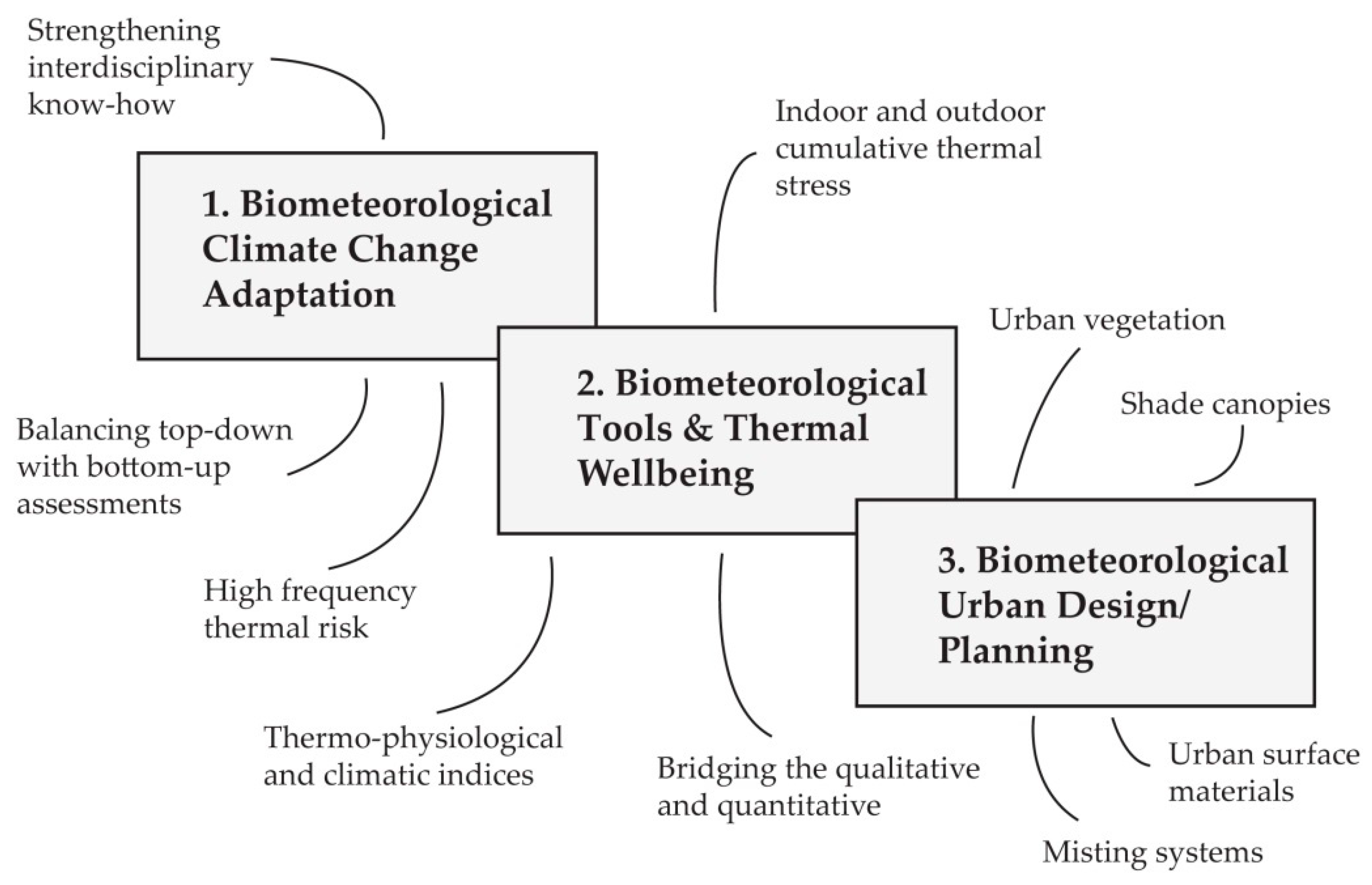
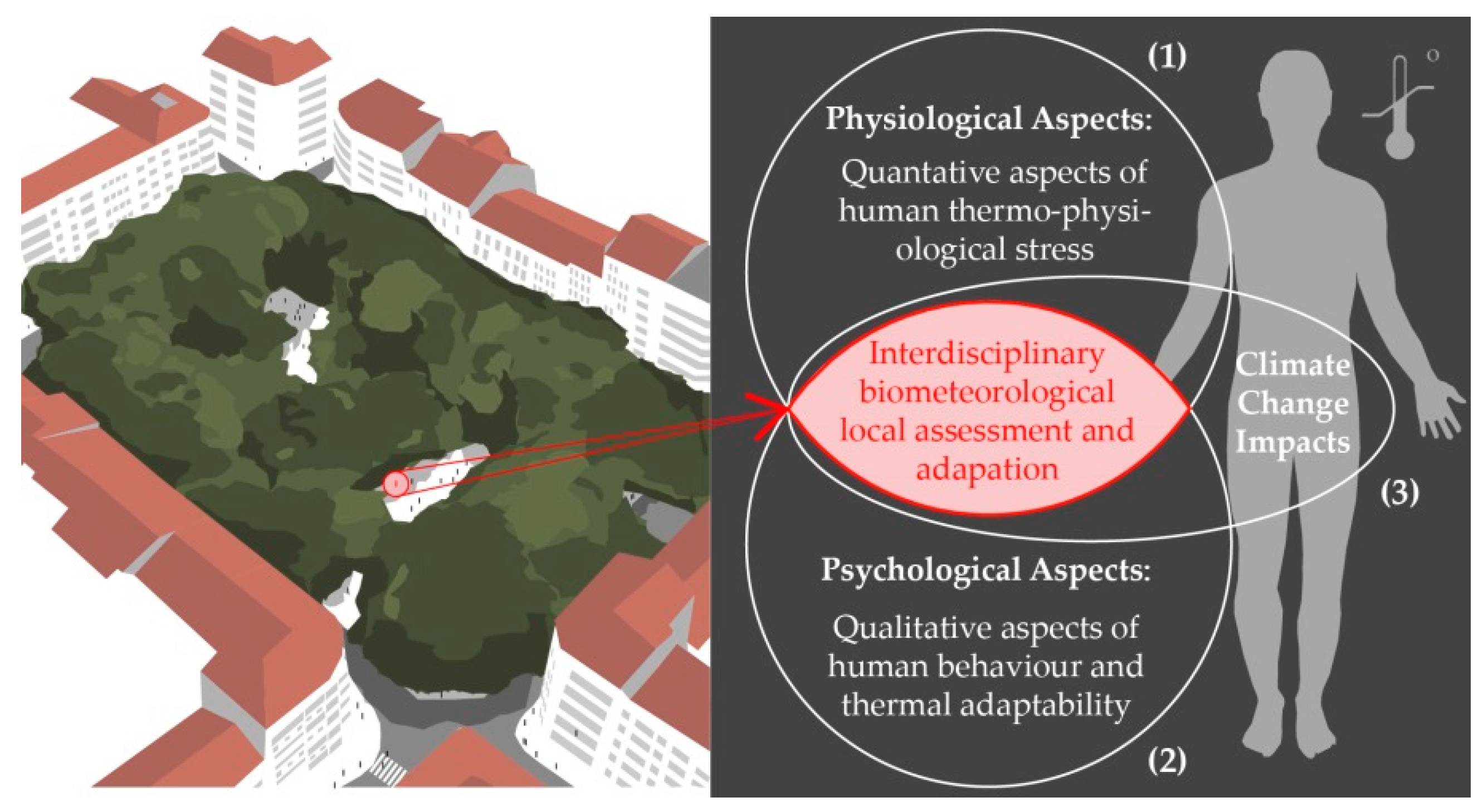
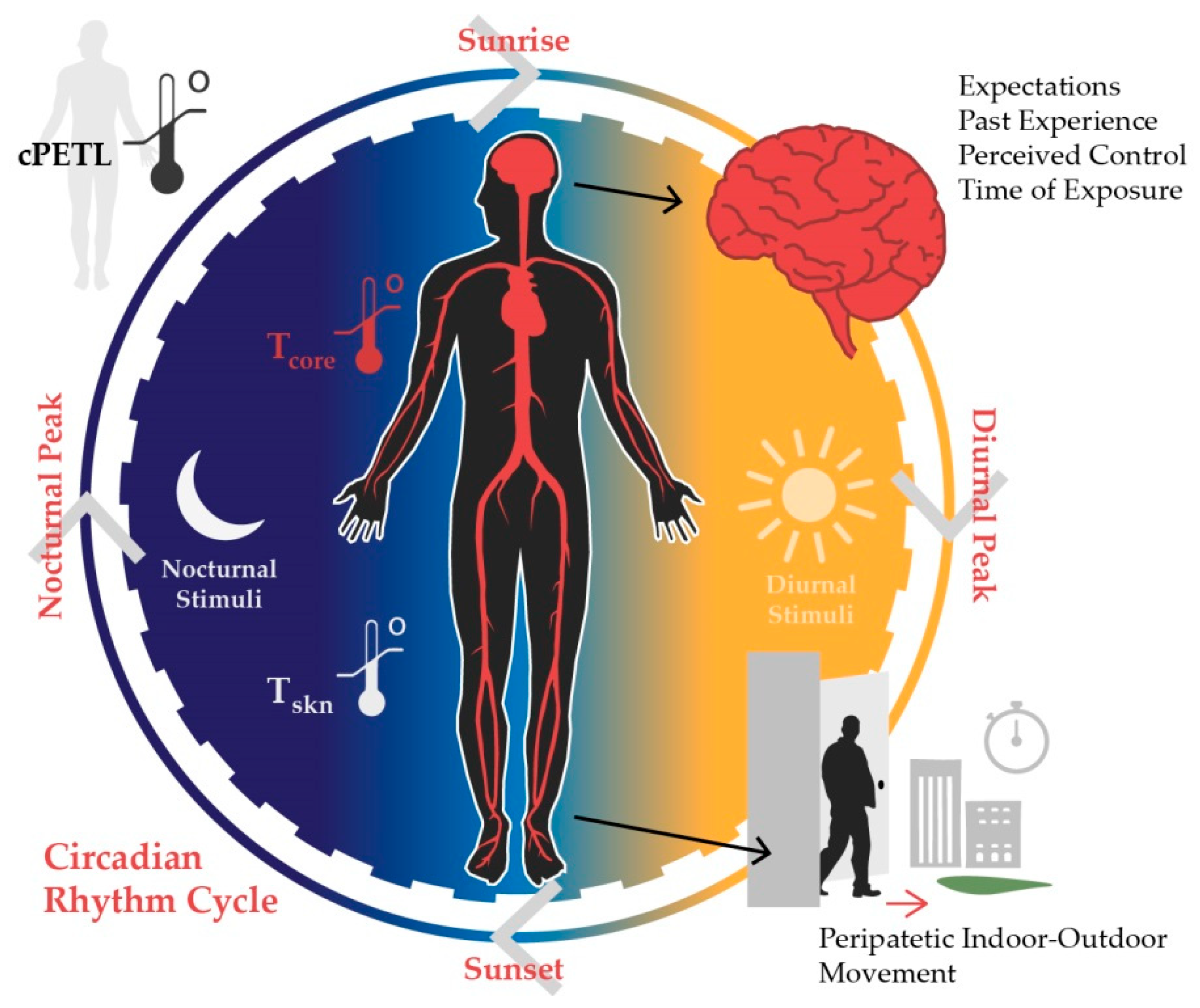
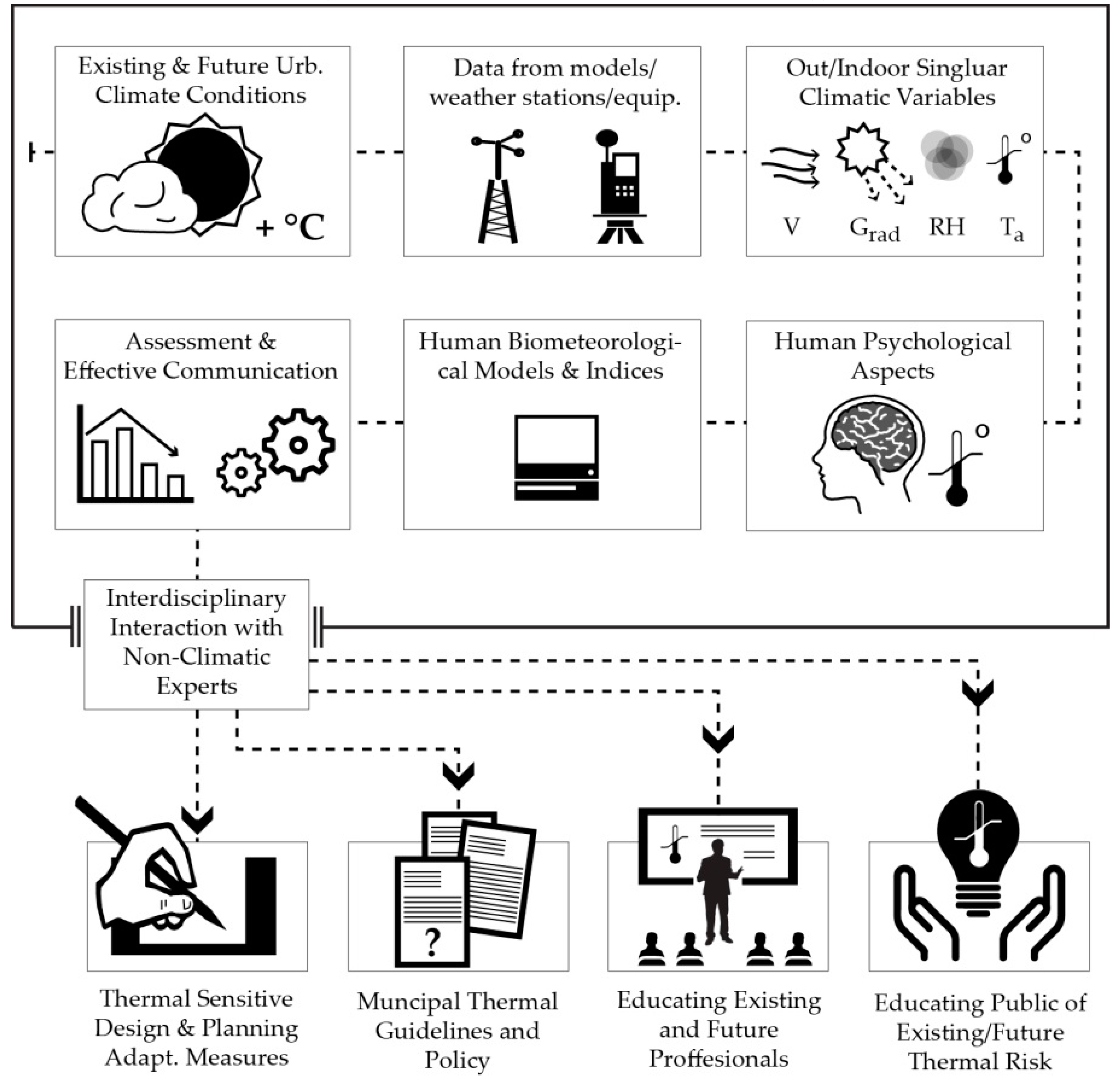
| No. of Investigated Indices | Dominant Focused Context | Region Specified | Year | Source |
|---|---|---|---|---|
| 5 | Not Stipulated | No | 1988 | [65] |
| 2 | Outdoor | Taiwan | 2012 | [66] |
| 40 | Outdoor | Mediterranean Zones | 2014 | [67] |
| 162 | Indoor/Outdoor | No | 2015 | [68] |
| 3 | Outdoor | Doha, Qatar | 2015 | [69] |
| 24 | Outdoor | Polar, Cold, Temperate, Arid and Tropical | 2016 | [70] |
| 165 | Indoor/Outdoor | No | 2016 | [71] |
| 4 specific (from 165) | Outdoor | No | 2018 | [47] |
| 6 | Outdoor | No | 2018 | [72] |
| 6 | Outdoor | Mediterranean Zones | 2019 | [73] |
| 6 | Outdoor | Mediterranean Zones | 2019 | [74] |
| 4 | Indoor/Outdoor | No | 2019 | [75] |
| 1 (MRT *1) | Indoor/Outdoor | No | 2019 | [76] |
| - (SVF *2) | Outdoor | No | 2019 | [77] |
| Index | Acronym | Typology | Source |
|---|---|---|---|
| Perceived Temperature | (PT) | (G)–Energy balance stress model | [78] |
| Standard Effective Temperature | (SET *) | (G)–Energy balance stress model | [79,80] |
| Outdoor Standard Effective Temperature | (OUT_SET *) | (G)–Energy balance stress model | [63,81] |
| Thermal Humidity Index | (THI) | (C)–Algebraic/statistical model | [82] |
| Predicted Mean Vote | (PMV) | (G)–Energy balance stress model | [28,83] |
| Predicted Percentage of Dissatisfied | (PPD) | (G)–Energy balance stress model | [28] |
| Humidex | (HD) | (C)–Algebraic/statistical model | [84] |
| Index of Thermal Stress | (ITS) | (F)–Energy balance strain model | [31] |
| Outdoor thermal comfort model | (COMFA) | (G)–Energy balance stress model | [85,86] |
| Universal Thermal Climate Index | (UTCI) | (G)–Energy balance stress model | [87,88,89] |
| Wet Bulb Temperature | (WBGT) | (B)–Single-parameter model | [90,91] |
| Predicted Heat Strain | (PHS) | (F)–Energy balance strain model | [92] |
| Physiologically Equivalent Temperature | (PET) | (G)–Energy balance stress model | [26,93,94] |
| modified Physiologically Equivalent Temperature | (mPET) | (G)–Energy balance stress model *1 | [95] |
| No. | Predominant Review Topic Summary | Icon | Study Year | Example Review Studies |
|---|---|---|---|---|
| (i) | Specific effects of green roofs, including indoor thermal behaviour, cooling loads and performance |  | 2014 | [160] |
| 2014 | [161] | |||
| 2018 | [162] | |||
| (ii) | Specific quantitative influences and performance of urban green walls/facades |  | 2014 | [163] |
| 2014 | [164] | |||
| 2017 | [165] | |||
| (iii) | Air quality and particles dispersion/abatement through the presence of vegetation |  | 2015 | [166] |
| 2015 | [167] | |||
| 2017 | [168] | |||
| (iv) | Overall socio-economic benefits, and challenges, of growing urban vegetation in the public realm |  | 2011 | [169] |
| 2015 | [170] | |||
| (v) | Wider social impacts of street vegetation upon urban ecosystems and communities | 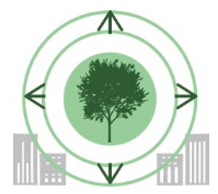 | 2016 | [171] |
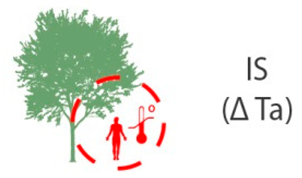 | ||||
|---|---|---|---|---|
| Thermal Result (Ta Max) | Location | KG | Study Year | Source |
| −1.5 °C | California | ‘Csa’ | 1988 | [173] |
| −0.7 °C | Tokyo | ‘Cfa’ | 2008 | [174] |
| −2.2 °C | Athens | ‘Csa’ | 2010 | [175] |
| −0.5 °C | Singapore | ‘Af’ | 2010 | [176] |
| −1.0 °C | Melbourne | ‘Cfb’ | 2013 | [177] |
| −1.0 °C | Manchester | ‘Cfb’ | 2014 | [178] |
| Table Result Avg. = −1.2 °C | ||||
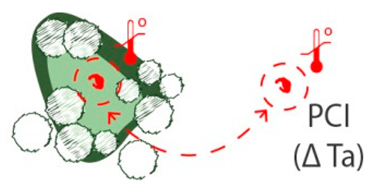 | ||||
|---|---|---|---|---|
| Thermal Result (Ta Max) | Location | KG | Study Year | Source |
| −4.0 °C | Mexico City | ‘Cwb’ | 1990-1 | [179] |
| −2.5 °C | Dehli | ‘BSh’ | 1990-1 | [180] |
| −3.0 °C | Kumanoto | ‘Cfa’ | 1991 | [181] |
| −2.5 °C | Fukuoka | ‘Cfa’ | 1993 | [182] |
| −2.0 °C | Tokyo | ‘Cfa’ | 1998 | [132] |
| −4.0 °C | (Scaled model) | - | 1999 | [183] |
| −4.0 °C | Tel Aviv | ‘Csa’ | 2000 | [184] |
| −4.0 °C | Botswana | ‘BSh’ | 2004 | [185] |
| −3.5 °C | Tel Aviv | ‘Csa’ | 2006 | [186] |
| −4.4 °C | Taipei | ‘Cfa’ | 2007 | [187] |
| −2.5 °C | Taipei | ‘Cfa’ | 2010 | [188] |
| −5.0 °C | Athens | ‘Csa’ | 2014 | [189] |
| −5.0 °C | Chania | ‘Csa’ | 2014 | [190] |
| −7.4 °C | Lisbon | ‘Csa’ | 2019 | [191] |
| Table Result Avg. = −3.9 °C | ||||
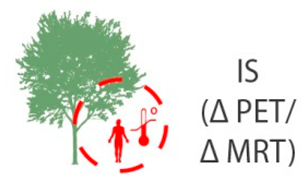 | ||||
|---|---|---|---|---|
| Thermal Result (PET/MRT Max) | Location | KG | Study Year | Source |
| −11.2 °C (PET) | Szeged | ‘Cfb’ | 2006 | [197] |
| −12.0 °C (PET) | São Paulo | ‘Cfa’ | 2008 | [198] |
| ≈−12.0 °C (MRT) | Huwei | ‘Cfa’ | 2010 | [199] |
| −20.0 °C (PET) | Shanghai | ‘Cfa’ | 2011 | [200] |
| −8.0 °C (PET) | Campinas | ‘Cwa’ | 2012 | [201] |
| −8.3 °C (PET) | Athens | ‘Csa’ | 2012 | [33] |
| −16.6 °C (PET) | Campinas | ‘Cwa’ | 2015 | [202] |
| −27.0 °C (MRT) | Manchester | ‘Cfb’ | 2016 | [203] |
| −4.6 °C (PET) | Toronto | ‘Dfb’ | 2016 | [22] |
| −3.4 °C (PET) | Hong Kong | ‘Cwa’ | 2017 | [204] |
| −9.9 °C (PET) | Lisbon | ‘Csa’ | 2017 | [108] |
| −15.6 °C (PET) | Lisbon | ‘Csa’ | 2018 | [99] |
| Table Result Avg. = −11 °C (PET)/−19.5 °C (MRT) | ||||
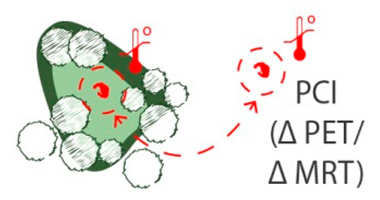 | ||||
|---|---|---|---|---|
| Thermal Result (PET/MRT Max) | Location | KG | Study Year | Source |
| −17.6 °C (PET) | Freiburg | ‘Cfb’ | 2003 | [205] |
| −9.0 °C (PET) | Freiburg | ‘Cfb’ | 2006 | [206] |
| −33.0 °C (MRT) | Lisbon | ‘Csa’ | 2007 | [207] |
| −10.7 °C (PET) | Tel Aviv | ‘Csa’ | 2010 | [208] |
| −39.2 °C (MRT) | Lisbon | ‘Csa’ | 2011 | [209] |
| −12.0 °C (PET) | Tel Aviv | ‘Csa’ | 2012 | [210] |
| −20.0 °C (MRT) | Milan, Genoa, Rome | ‘Cfa’, ‘Csa’, ‘Csa’ | 2014 | [211] |
| −10.0 °C (PET) | Toulouse | ‘Cfb’ | 2016 | [212] |
| −18.0 °C (PET) | Tel Aviv, Beer Sheva, Eilat | ‘Csa’, ‘BSh’, ‘BWh’ | 2017 | [4] |
| Table Result Avg. = −12.3 °C (PET)/−30.7 °C (MRT) | ||||
 | |||||
|---|---|---|---|---|---|
| Thermal Result (Ta Max) | Location | KG | Study Method. | Study Year | Source |
| –2.0 °C | Nagoya | ‘Cfa’ | Field Study | 2008 | [232] |
| –1.5 °C | Tokyo | ‘Cfa’ | Field Study | 2008 | [233] |
| –2.5 °C | Tokyo | ‘Cfa’ | CFD * Study | 2008 | [234] |
| –2.0 °C | Yohohama | ‘Cfa’ | CFDStudy | 2009 | [231] |
| –0.8 °C | Osaka | ‘Cfa’ | Field + CFD Study | 2011 | [235] |
| Table Result Avg. = –1.8 °C | * CFD—Computational Fluid Dynamic | ||||
© 2019 by the authors. Licensee MDPI, Basel, Switzerland. This article is an open access article distributed under the terms and conditions of the Creative Commons Attribution (CC BY) license (http://creativecommons.org/licenses/by/4.0/).
Share and Cite
Santos Nouri, A.; Matzarakis, A. The Maturing Interdisciplinary Relationship between Human Biometeorological Aspects and Local Adaptation Processes: An Encompassing Overview. Climate 2019, 7, 134. https://doi.org/10.3390/cli7120134
Santos Nouri A, Matzarakis A. The Maturing Interdisciplinary Relationship between Human Biometeorological Aspects and Local Adaptation Processes: An Encompassing Overview. Climate. 2019; 7(12):134. https://doi.org/10.3390/cli7120134
Chicago/Turabian StyleSantos Nouri, Andre, and Andreas Matzarakis. 2019. "The Maturing Interdisciplinary Relationship between Human Biometeorological Aspects and Local Adaptation Processes: An Encompassing Overview" Climate 7, no. 12: 134. https://doi.org/10.3390/cli7120134
APA StyleSantos Nouri, A., & Matzarakis, A. (2019). The Maturing Interdisciplinary Relationship between Human Biometeorological Aspects and Local Adaptation Processes: An Encompassing Overview. Climate, 7(12), 134. https://doi.org/10.3390/cli7120134






